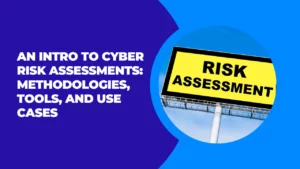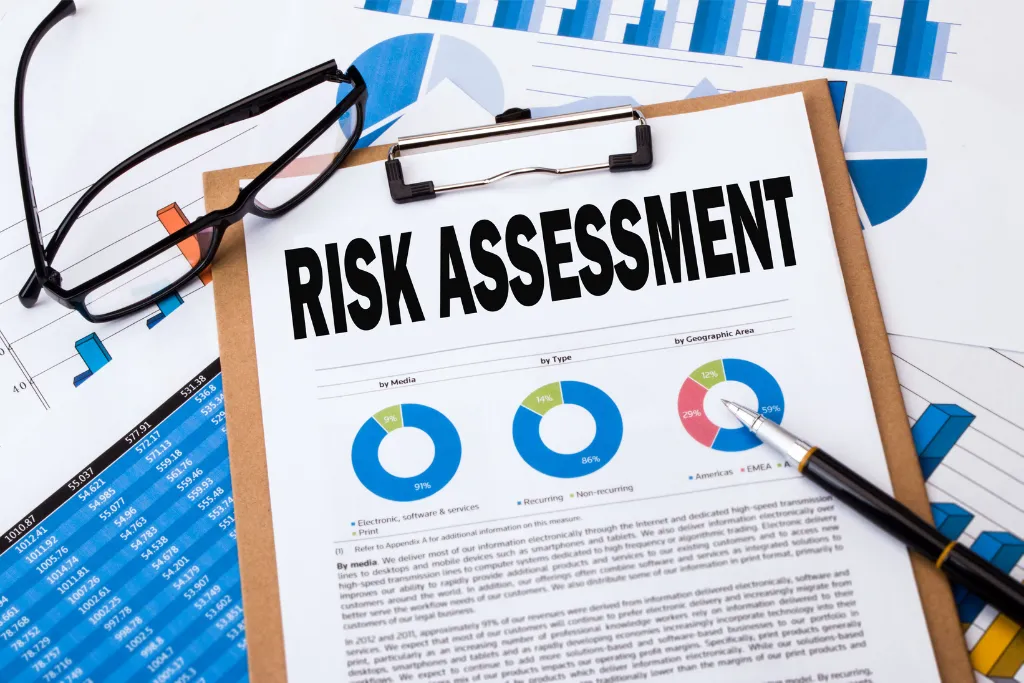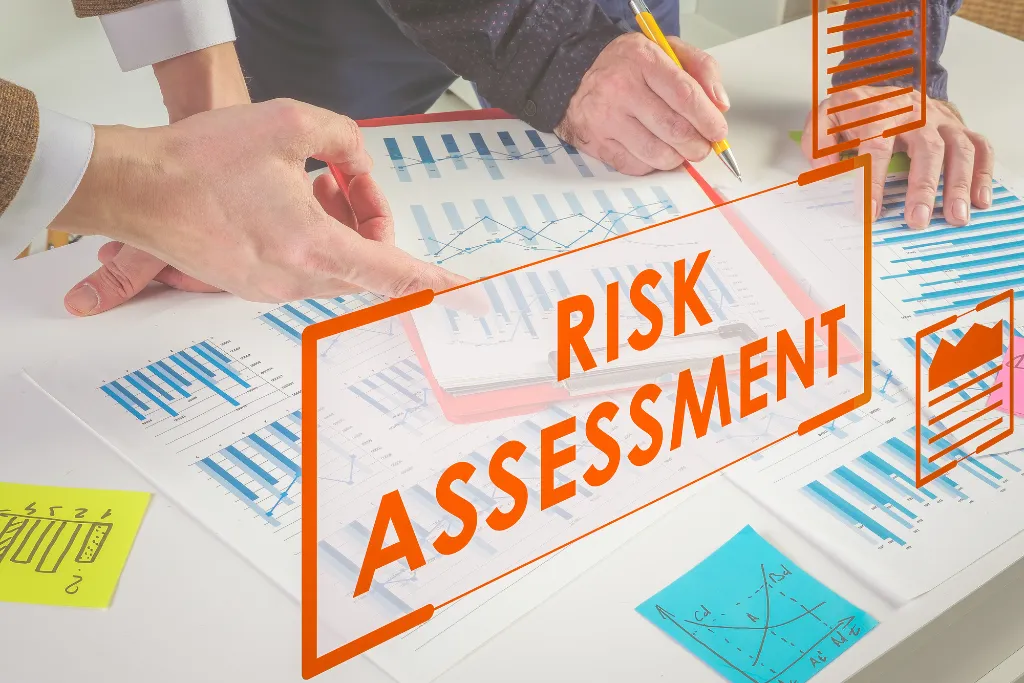Physical Address
304 North Cardinal St.
Dorchester Center, MA 02124
Physical Address
304 North Cardinal St.
Dorchester Center, MA 02124

In today’s digital world, where everything from personal data to sensitive business information is stored online, cyber risk assessments have become essential. A cyber risk assessment is a comprehensive evaluation of an organization’s security posture and vulnerabilities in its technology infrastructure.
It helps identify potential threats and provides recommendations for mitigating them. In this blog, we will cover the basics of cyber risk assessments, including their methodologies, tools, and real-world use cases.
We will explore different approaches used in conducting assessments, the features to look for in a tool, and the step-by-step process of implementing an assessment.
We will also examine why cyber risk assessments are crucial for every organization and what lessons can be learned from high-profile cases.

Understanding Cyber Risk Assessments is crucial for organizations in protecting themselves from cyber threats. These assessments analyze potential hazards and vulnerabilities, allowing stakeholders to identify and prioritize risks. ISO 31000 provides guidelines for effective risk assessment, ensuring that organizations follow best practices.
By involving stakeholders in the risk management process, organizations can gain a comprehensive understanding of their risk landscape. Through risk analysis and estimation, organizations can gauge the severity of possible scenarios and take necessary measures to minimize property damage.
The use of occupational safety and health protocols helps organizations mitigate high-risk factors and achieve lower risk scores.
In today’s digital world, the constantly evolving and increasing cyber threats pose a significant risk to organizations. This is where cyber risk assessments come into play. By assessing the probability and potential impact of cyberattacks, organizations can gain valuable insights and take proactive measures for risk management and prevention.
Neglecting cyber risk assessments leaves organizations more vulnerable to attacks, jeopardizing sensitive information and business continuity. It is crucial for organizations to prioritize cyber risk assessments to protect themselves from possible scenarios of property damage and ensure occupational safety and health. Effective risk assessments with lower scores help in better risk analysis and estimation.
Quantitative approaches in cyber risk assessments involve assigning numerical values to risk factors, allowing for more precise analysis. On the other hand, qualitative analysis relies on expert judgment and experiences to assess risks.
The risk assessment process encompasses hazard identification, risk evaluation, and risk estimation. To visually prioritize risks, risk matrices are commonly utilized. It’s important to note that different industries may require specific methodologies tailored to their unique risks. NLP terms: risk analysis, high-risk, lower scores, risk estimate, possible scenarios.
Quantitative risk assessments involve the use of numerical values to quantify risks, providing a clear and structured approach to assessing potential threats. On the other hand, qualitative approaches rely on expert opinions and subjective evaluations, taking into account factors that may not be easily quantifiable.
Each approach has its strengths and limitations, making it important to consider the organization’s needs and available resources when choosing the right methodology. Combining quantitative and qualitative methods can provide a more comprehensive risk assessment, allowing organizations to make informed decisions and prioritize their actions.
By exploring different approaches, organizations can gain a deeper understanding of their risk landscape and effectively manage potential vulnerabilities.
Read More: A Primer on Cyber security Controls in 2024: Types, Implementation, and Management
Cyber risk assessment tools play a crucial role in automating and streamlining the risk assessment process. These tools offer features such as hazard analysis and risk management capabilities, enabling organizations to efficiently identify vulnerabilities.
Customizable risk evaluation criteria are essential for effective risk assessment tools. Additionally, visualizations and reports provided by these tools make it easier to interpret the results and make informed decisions.
By utilizing information technology and information security tools, organizations can enhance their risk assessment process and effectively mitigate potential risks.
When selecting a cyber risk assessment tool, there are several key features to consider. First and foremost, a user-friendly interface simplifies the risk assessment process, making it easier for users to navigate and input data.
Additionally, the tool should allow for customization to fit specific organizational needs, ensuring that it aligns with the unique requirements of your business. Integration with other security tools is also important, as it enhances the overall risk management process by providing a comprehensive view of vulnerabilities and threats.
Look for tools that offer comprehensive risk evaluation and measurement capabilities, allowing you to assess risks across various dimensions. Furthermore, automated data collection and analysis save time and improve accuracy, enabling efficient risk assessment and mitigation.
By considering these features, organizations can ensure they choose a cyber risk assessment tool that meets their specific needs.
To implement a cyber risk assessment, start by establishing clear goals and objectives. Define the scope and boundaries of the assessment, and gather relevant data on potential risks.
Analyze the data using your chosen methodology, and communicate the findings and recommendations. Document action plans for future reference.
To successfully conduct a risk assessment, it is important to define its purpose and scope. This involves clearly understanding why the assessment is being conducted and what areas it will cover.
Next, potential threats and vulnerabilities need to be identified to have a comprehensive view of the risks involved. Assessing the likelihood and impact of each risk is then crucial to prioritize mitigation efforts effectively.
By determining risk levels and assigning appropriate scores, organizations can focus on addressing high-risk areas first. Finally, developing and implementing risk treatment plans will help mitigate potential damage and ensure the security of valuable resources.

High-profile cyber risk assessments provide valuable lessons and insights. Organizations like Equifax and Target have faced significant financial and reputational damages due to cyberattacks. Lessons learned from these cases emphasize the importance of proactive risk assessments and mitigation strategies.
Cyber risk assessments play a crucial role in helping organizations anticipate and address emerging threats. By conducting effective risk assessments, organizations can contribute to improved cybersecurity posture and incident response. Assessing risks through methods such as risk analysis helps identify high-risk areas and potential scenarios for property damage.
This enables organizations to prioritize their efforts and allocate resources effectively, resulting in lower scores on risk estimates. Occupational safety and health are enhanced when possible scenarios are analyzed and addressed through comprehensive risk assessments.
High-profile cyber risk assessments provide valuable insights into the consequences of neglecting cybersecurity. Equifax’s data breach highlighted the importance of regular vulnerability assessments and patch management, while the Target breach emphasized the need for network segmentation and access control.
These cases demonstrate the potential property damage and reputational harm that can result from inadequate risk assessments. To effectively manage cybersecurity risks, organizations must continuously monitor and update their assessments to keep up with evolving threats.
By learning from past incidents and investing in robust risk management practices, organizations can mitigate high-risk scenarios and protect their occupational safety and health.
Understanding the importance of cyber risk assessments in today’s digital world is vital. By identifying potential hazards and vulnerabilities, organizations can prioritize resources and make informed decisions to manage cybersecurity effectively.
Cyber risk assessments provide valuable insight into the risk landscape, ensuring the protection of critical assets and business continuity.
In conclusion, cyber risk assessments are crucial in today’s digital world to protect organizations from potential threats and vulnerabilities. By understanding the methodologies and tools used in these assessments, organizations can effectively identify and mitigate risks.
Implementing a step-by-step process ensures a comprehensive assessment of cybersecurity posture. Real-world use cases highlight the importance of cyber risk assessments in preventing data breaches and financial losses.
It is essential for every organization, regardless of size or industry, to prioritize cyber risk assessments to safeguard sensitive information and maintain business continuity. Take proactive steps to secure your organization and minimize cyber risks. Start by evaluating your current cybersecurity measures and consider investing in a reliable cyber risk assessment tool.